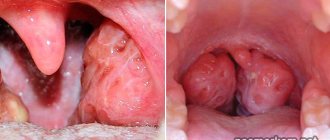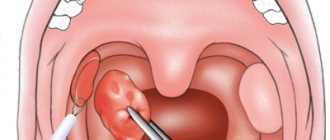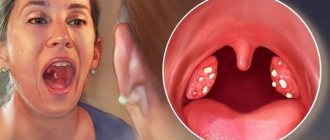The inflammatory process in the tonsils (tonsillitis) may be accompanied by tonsillitis plugs. A plug in the palatine tonsil is an accumulation of purulent masses in its lacunae. Such formations not only bring discomfort to the patient, but can also provoke serious complications. In our article we will tell you how to get rid of tonsillitis stones and how to treat purulent tonsillitis in Moscow.
The tonsils of a healthy body are capable of self-cleaning. With frequent or prolonged sore throats, this function of the tonsils weakens; white or yellowish lumps, consisting of dead leukocytes, bacteria, calcium and other substances, begin to accumulate in the lacunae - these are almond stones or tonsillitis. More often, this problem occurs with chronic tonsillitis, when the patient begins to self-medicate, starting to take certain medications uncontrollably, or does not follow doctor’s orders and stops taking antibiotics ahead of schedule.
Causes and symptoms of the disease
Inflammation in the tonsils, leading to the appearance of plugs, can be caused by the following reasons:
- existing chronic diseases of the ENT organs (for example, chronic rhinitis);
- inflammatory processes in the oral cavity (carious teeth) and nasal cavity (sinusitis);
- deformed nasal septum;
- increase in the size of adenoid vegetations;
- weakened immune system, stress;
- hypothermia of the body;
- tonsil injuries
The main causative agents of tonsillitis are staphylococci, streptococci, and adenoviruses.
The formation of plugs is indicated by symptoms such as: bad breath, visible accumulations of pus on the tonsils, enlargement of the palatine arches, enlarged lymph nodes, pain when swallowing. The patient complains of constant weakness. The temperature may rise, and in some cases the pain radiates to the ear.
When the first symptoms appear, it is necessary to promptly remove tonsillitis caseous masses so as not to start the disease and prevent possible complications: rheumatism, heart disease, kidney disease, etc.
What are tonsils?
Tonsils are lymph nodes located superficially in the oropharynx between the palatine arches. They represent an organ of immune defense against the threat of pathogenic microorganisms entering the lower respiratory tract, that is, an organ designed to purify the inhaled air from infection, or to localize this infection (take the fire upon itself) in order to prevent its spread below.
Healthy tonsils are formations permeated with “lacunae” and “crypts” (folds and passages), this is designed to greatly increase the surface of the working epithelium, which produces protective antibodies and immunoglobulins. That is, the intentions to have such a “multi-pass” structure are absolutely good. But, as you know, all our advantages are also our shortcomings. So in this case, if healthy tissue of the tonsil should self-clean, and lacunae (pockets) and crypts (passages) should not accumulate any contents, then the tonsil, exhausted from work, cannot cope with this function and accumulates desquamated epithelium in its “feeds”, and sometimes food remains in the form of whitish-yellowish masses, which are an excellent environment for the development of bacteria, as evidenced by the unpleasant odor from these accumulations.
Patients themselves notice that some content accumulates in the tonsils, either by determining this visually, or by the feeling of a foreign body on the right or left, “tingling” when swallowing, sometimes this discharge can be coughed up and spat out, or is discovered as an accidental finding when examining the throat by an otolaryngologist .
In this case, the tonsil no longer works as a protective organ and is rather a source of infection.
Chronic tonsillitis in children
The diagnosis of chronic tonsillitis is detected in 15% of children. In childhood, the most common cause of chronic inflammation of the tonsils is untreated tonsillitis (acute tonsillitis). Also, chronic tonsillitis can develop against the background of adenoids, dental diseases, a deviated nasal septum, allergies, hypothermia and weak immunity. The hereditary factor plays a major role. If the mother or father of the child has a history of this diagnosis, then the child is likely to develop the disease as well.
Causes of purulent plugs
The appearance of caseous plugs indicates that the inflammatory process in the tonsils has become chronic. Most often this occurs due to improper treatment of acute tonsillitis - tonsillitis. Someone self-medicates and takes the wrong medications, someone, feeling relief, abandons the treatment prescribed by the ENT doctor, and as a result, the inflammation does not go away. Both options do not bring anything good to the patient: acute tonsillitis becomes chronic with the formation of tonsillitis plugs. This is the most common reason.
Treatment of tonsillitis plugs
Palatine tonsils in Moscow should be treated under the supervision of an otolaryngologist. Conservative treatment of tonsil plugs in Moscow includes the use of antibiotics (amoxcillin, sumamed, erythromycin), rinsing with antiseptics (Miramistin, Rotokan, Chlorhexidine), and lubricating the tonsils with Lugol's solution. To relieve pain, you can dissolve special lozenges (“Faringosept”, “Strepsils”). To relieve swelling, antihistamines are prescribed. If you have a fever, you need to take antipyretics.
Removing plugs using a vacuum using the Tonsillor device is highly effective. First, using the Tonsillor nozzle, a vacuum is created to remove purulent masses - the purulent contents of the lacunae are sucked out into a special cup. After treatment (sanitation), the palatine tonsil is exposed to ultrasound.
The main rule when removing traffic jams is that you cannot get rid of the problem at home.
Some patients try to clean their tonsils themselves by scooping out the pus with their fingers or a toothpick. Firstly, this measure is ineffective, since only plaque on the surface is removed, and not accumulations of pus inside the lacunae; secondly, this can injure the tonsils.
Is it possible to cure traffic jams at home?
People suffering from chronic tonsillitis ask the question: “How to remove purulent plugs in the throat?” The vast majority do not seek to contact an otolaryngologist, trying to remove plugs from the throat on their own.
The first method that patients practice at home is squeezing out the plugs with their tongue. By pressing on the tonsil with your tongue, you can remove a small plug in your mouth. This method cannot be called traumatic, but it is also effective. Large purulent accumulations, as well as plugs deep in the lacunae, cannot be reached this way.
The second method is squeezing out caseous masses with a spoon. The algorithm of actions is the same - press on the tonsil so that the purulent “lumps” come out. But the tissues of the inflamed tonsils are very thin, and without taking into account the force of pressure, they can be injured. As a result, the tonsils will begin to bleed. If the procedure is carried out carelessly, without maintaining sterility (and this is difficult to do at home, no matter how hard you try), the wounds can become infected.
Removing caseous mass from the tonsils using these methods is ineffective. Even if the procedure took place without unpleasant consequences, caseous detritus, embedded deep in the thickness of the tonsil, will remain there and will continue to support inflammation. This means the problem will not go away.
Only an ENT doctor can effectively treat purulent plugs.
Surgery
In case of ineffective treatment with conservative methods or frequently recurring tonsillitis (if inflammation occurs more than 2-3 times a year), the ENT doctor may recommend partial or complete removal of the tonsils. The operation is called tonsillectomy. It has a number of contraindications, such as: blood diseases, diabetes, kidney disease, tuberculosis and a number of others. There are several options for performing a tonsillectomy:
- using scissors, a loop and a scalpel;
- using a laser;
- ultrasonic scalpel;
- cold radio knife (coblation).
The operation itself lasts about half an hour. After it, a sore throat, nausea, and bleeding are possible. Depending on the method of surgical intervention, the patient is discharged 2-10 days after the intervention. The attending physician will definitely give a number of recommendations that will need to be followed at home for a speedy recovery.
Complications of tonsillitis plugs
- Peritonsillar abscess is an acute purulent inflammation of the peritonsillar tissue, when bacteria from the tonsils spread to nearby tissues. The main symptoms of the disease are acute sore throat on one side, bad breath, spasms of the chewing muscles, and high body temperature.
- Cellulitis of the neck is a purulent-inflammatory disease when infection from the tonsils penetrates into the tissue of the neck. The main signs are a rapidly growing lump in the neck, high body temperature, difficulty moving the head, swallowing and breathing. The condition is life-threatening for the patient.
- Heart diseases: arrhythmia, myocarditis, endocarditis.
- Kidney diseases: pyelonephritis, glomerulonephritis.
- Joint diseases: rheumatism, scleroderma, systemic lupus erythematosus.
- Complications of pregnancy: miscarriage, premature birth.
- Hair loss. The body begins to consider hair follicles as foreign structures, and active hair loss begins.
- Skin diseases: dermatosis, psoriasis, neurodermatitis, acne.
- Hormonal imbalances, which lead to excess weight, diabetes, and decreased male reproductive function.
- Problems with the nervous system: headaches, tinnitus, lack of sleep, fatigue.
- Excessive sweating.
Why do plugs form in the throat?
The main cause of traffic jams is considered to be chronic tonsillitis. Some patients, having fallen ill with a sore throat (or acute tonsillitis), neglect qualified medical care, take medications uncontrollably, complete a course of antibiotics ahead of time, or do nothing at all in the hope that everything will go away on its own. As a result, a chronic disease develops, the consequence of which is the formation and deposition of caseous detritus in the tonsils.
Chronic tonsillitis is a disease in which periods of exacerbation are followed by a resting stage, when the sore throat does not bother the patient for some time.
But in moments of exacerbation, the symptoms, and with them the traffic jams, return.
The formation of purulent accumulations can also be provoked by:
- injuries and mechanical damage to the tonsils (for example, due to hard or tough food, bones accidentally falling into the throat, etc.);
- acute infectious diseases, such as purulent types of tonsillitis, also occur with the formation of tonsillitis plugs;
- anatomical features of the structure of the palatine tonsils - there are cases when the lacunae of a person’s tonsils are enlarged, and this is the norm for him. In such tonsils, the self-cleaning process is difficult, which leads to the accumulation of purulent masses in their thickness.
Indirect causes of traffic jams also include bad habits, poor environment, deviated nasal septum, dental problems - all these factors weaken the body’s defenses and lead to the formation of foci of infection.
Signs of a blockage in the throat.
To diagnose tonsillitis plugs in yourself, you do not need a medical education: they are visible if you look in the mirror and open your mouth wide. Their appearance (if we are talking about chronic tonsillitis) coincides with the beginning of an exacerbation of the disease. But other signs also indicate the presence of caseous detritus in the lacunae of the tonsils.
- Bad breath.
- A sore throat
- Discomfort while swallowing.
- Thickening of the palatine arches.
- The surface of the tonsils becomes loose, adhesions and scars appear.
- Increase in body temperature to 37.5℃.
- Sensation of the presence of a foreign body in the throat (if the plugs are large).
- Malaise, weakness.
Caseous masses are pus, and pus tends to smell extremely unpleasant. Moreover, this smell is felt not only by the patient, but also by those around him. It is this symptom that brings many patients to the otolaryngologist’s office to remove blockages from their throat.
All these symptoms are a good reason to contact an ENT doctor to carry out comprehensive treatment of tonsillitis, including drug therapy, removal of tonsillitis plugs and physiotherapeutic procedures.
Prevention measures
To reduce the likelihood of tonsillitis plugs, you need to follow a number of preventive measures:
- Maintain your dental hygiene. Do not forget to brush your teeth in the morning and evening, rinse your mouth after eating, this will prevent the growth of pathogenic microflora in the oral cavity.
- Treat carious teeth and other oral diseases in a timely manner. Visit your dentist once every six months for preventative care. Do not delay treatment for nasopharyngeal diseases. When the first signs of such diseases appear, contact an ENT doctor.
- Strengthen your body's immunity: spend more time outdoors, eat a balanced diet, engage in physical activity, and give up bad habits.
- Dress according to the weather: do not get too cold or overheat.
FAQ
How can you get tonsillitis?
Chronic tonsillitis cannot be contracted.
Chronic inflammation of the palatine tonsils is most often a consequence of untreated tonsillitis (acute tonsillitis), as well as the effect on the human body of a number of provoking factors: poor ecology, constant interaction with harmful substances at work, hypothermia, poor diet, stress, the presence of chronic diseases of the nasopharynx, bad habits , weakened immunity. Do inhalations help with tonsillitis?
Inhalations can be used as part of the drug treatment of chronic tonsillitis.
But if you rely only on them, there will be no result. An integrated approach is important in treating the disease. The correct treatment tactics include drug therapy, washing the palatine tonsils from tonsillitis plugs, as well as physiotherapeutic procedures. Only this approach will bring a positive therapeutic effect. Do I need to follow a diet if I have a congestion in my throat?
Of course, you need to adjust your diet.
Do not get carried away with fried, spicy, sour, and over-salted foods. Do not consume citrus fruits or alcohol. Food should not be too hot or, conversely, cold. In a word, avoid everything that can irritate the mucous membrane of the pharynx and tonsils. Are tonsil plugs dangerous during pregnancy?
Yes, chronic tonsillitis during pregnancy carries a risk of miscarriage or premature birth. If a girl has chronic tonsillitis, before planning a pregnancy, it is recommended to undergo a course of comprehensive treatment for chronic tonsillitis in order to reduce the bacterial load on the body, and then repeat the treatment in the second trimester.
Treatment methods for chronic tonsillitis
The choice of treatment method depends on the form of tonsillitis and, if it is decompensated, then the type of decompensation is taken into account.
Before starting treatment, carious teeth and inflammation in the nose and paranasal sinuses should be cured.
There are two main treatment methods:
- surgical
- conservative.
Despite the wide market of medical services, there are not so many effective methods for treating chronic tonsillitis. This is due to the multicomponent pathogenesis of the inflammatory process in the palatine tonsils and the anatomical features of the structure of the organ. One of the main pathological processes occurring in the palatine tonsils during chronic tonsillitis is a degenerative process, as a result of which the lymphoid tissue that normally makes up the organ is replaced by scar, connective tissue, which contributes to a more comfortable development of the bacterial flora and the progression of the inflammatory process and intoxication of the whole body. In chronic tonsillitis, microbial contamination of the entire area of the mucous membrane of the upper respiratory tract (oropharynx, nasopharynx, nasal cavity) occurs, therefore it is correct to treat the entire upper respiratory tract when treating chronic tonsillitis.
Very often, chronic tonsillitis is accompanied by chronic pharyngitis; it is very important to simultaneously treat it. It is possible to treat chronic tonsillitis during the period of exacerbation; it is necessary to relieve the symptoms of sore throat and then immediately begin treatment of chronic tonsillitis.
Surgical methods for treating chronic tonsillitis
A tonsillectomy is the removal of the tonsils. Surgical treatment may include either complete removal of the tonsils (most often done) or partial removal for large tonsils (done much less frequently). As a rule, surgery is prescribed for decompensated tonsillitis and in cases where repeated conservative treatment has not improved the condition of the tonsils.
Of course, in some cases it is impossible to do without a surgical approach, but for this there must be strong indications, such as recurrent peritonsillar abscesses, or serious associated diseases such as glomerulonephritis, endocarditis, sepsis arising from a sore throat. The fact is that often in a hurry with the removal of palatine tonsils, then in the future a number of diseases may arise that greatly worsen the quality of life and are difficult to treat, accompanied by a constant feeling of a lump in the throat; one of these diseases is chronic atrophic pharyngitis. In case of chronic tonsillitis not complicated by such serious diseases, it is more correct to start with conservative treatment; it is important that the treatment of chronic tonsillitis be comprehensive, aimed at all important links in the pathogenesis of the disease, namely, the sanitation of the entire area of the mucous membrane of the upper respiratory tract, the restoration of the structure of the organ and the stabilization of local immunity. With this approach, chronic tonsillitis can be cured.
Surgical methods also include galvanocaustics and diathermocoagulation of the tonsils (now rarely used). In recent years, new methods of surgical treatment have been developed, these are laser lacunotomy or tonsillectomy , using a surgical laser. The tonsils are also affected by surgical ultrasound. A fairly common cryosurgical method is freezing the tonsils. The method is used for small tonsils; some doctors also sound the tonsils with ultrasound before freezing, which helps reduce the tissue reaction to freezing and improve the healing of the wound surface on the tonsils.
Treatment at the ENT Clinic of Doctor Zaitsev
You can remove tonsillitis plugs in Moscow effectively and painlessly in our clinic. The high professionalism and extensive experience of the clinic’s specialists allows us to confidently declare: the treatment of chronic tonsillitis is our specialty. We use the most modern equipment from leading global manufacturers. Here you can get rid of almond plugs with a vacuum using the improved “Tonsillor” nozzle. This is our invention, our “know-how”, which has no analogues in Moscow. This attachment is much more effective than the usual Tonsillor attachment, less traumatic and painless. The procedure for cleansing the tonsils using this attachment becomes much more effective. It can even be used when treating children.
Prices in our clinic have not changed for 3 years, and are among the best in the capital. Call, make an appointment and come! We will help you cope with the disease!
Always yours, Doctor Zaitsev.
About the author:
ENT doctor of the highest category, candidate of medical sciences. Sci.
Removing tonsillitis plugs: how to remove them correctly?
Removal of caseous masses from the lacunae of the palatine tonsils is the most important part of the treatment of chronic tonsillitis, which should be carried out by an experienced ENT doctor in the clinic. Many patients mistakenly believe that they can remove the purulent contents of the tonsils on their own. A wide variety of items are used: from spoons and matches to toothpicks. Some people manage to remove traffic jams with cotton swabs or their tongue. But we strongly do not recommend resorting to such measures. Attempts to pick out purulent plugs can result in damage to the delicate tissues of the tonsils and infection of the wounds, since rarely do any patients observe proper sterility standards during the procedure.
Modern ENT clinics offer two ways to get rid of plugs: rinsing the palatine tonsils with a syringe and rinsing the palatine tonsils using the Tonzillor apparatus. Removing plugs with a syringe is done less and less often: this method is traumatic and does not allow you to fully wash the tonsils.
The second method is considered the most effective. The nozzle of the Tonsillor device is brought to the tonsil and, like a vacuum cleaner, draws out the purulent contents of the tonsils into the nozzle cup. True, due to the fact that the nozzle cup is opaque, the ENT doctor does not always see whether the tonsils are completely washed - so he has to carry out several additional procedures to remove the caseous masses for sure.
"Doctor Zaitsev's ENT Clinic" offers a third method: removing plugs using a modified attachment of the "Tonsillor" device.
There are no analogues of such a nozzle in any of the Moscow clinics, since it is a unique development of the founder of the “ENT Clinic of Doctor Zaitsev” - Vladimir Mikhailovich Zaitsev and his colleagues.
The improved nozzle is much more convenient than its predecessor. Its rounded edges do not injure the tissue of the tonsils, which sometimes happens with a conventional nozzle, and the transparent cup of the nozzle, into which the contents of the lacunae are washed out, immediately helps the doctor understand when the procedure can be completed without conducting unnecessary sessions. Thereby saving the patient time and money. The attachment can be used even when treating small patients - its small size is ideal for children.










